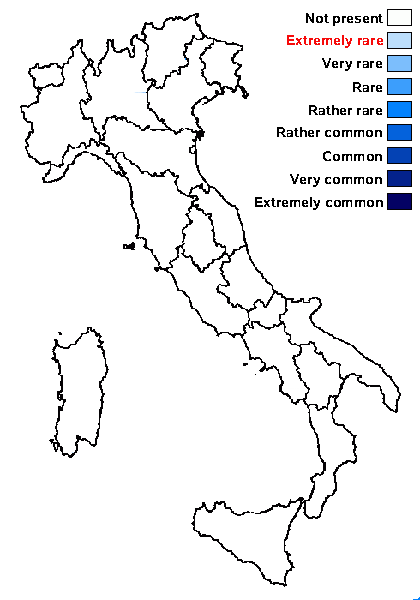Protoblastenia laeta (Poelt) Kainz & Rambold
Bibl. Lichenol., 88: 292, 2004.. Basionym: Protoblastenia calva var. laeta Poelt - Mitt. bot. Staats. Muenchen, 17-18: 390, 1957.
Synonyms:
Distribution:
Description: Thallus crustose, episubstratic, 0.1-0.5 mm thick, rimose to areolate, whitish, grey or pale brown, the areoles angular, concave to flat, up to 0.5 mm wide. Apothecia biatorine, bright yellow-orange to bright orange, 0.45-1(-1.7) mm across, semi-immersed to sessile, not or only slightly constricted at base, weakly to strongly convex and soon immarginate. Proper exciple thin, of parallel-radiating hyphae, colourless to yellowish, patchily pigmented; epithecium orange-brown, 10-15 µm high, with granular crystals reacting K+ purple-red, N-; hymenium colourless to pale orange, 100-150 µm high; paraphyses coherent, sparingly branched and anastomosing, 2-3.5 µm thick at mid-level, the apical cells slightly swollen, up to 4.5 µm wide; hypothecium orange to pale yellow, patchily pigmented. Asci 8-spored, clavate, with a well-developed, amyloid tholus containing a more intensely amyloid, indistinct tube structure, without an ocular chamber, approximating the Porpidia- or Psora-types. Ascospores 1-celled, hyaline, ellipsoid to ovoid, 11-15(-17) x 6-7.5 µm, without a distinct perispore. Photobiont chlorococcoid. Spot tests: thallus K-, C-, KC-, P-; apothecia K+ purple-red. Chemistry: apothecia with anthraquinones, mainly parietin. Note: on shaded calcareous rocks, usually on steep, north-exposed rock faces; widespread in Europe but rare, with a few records from the Eastern Alps (Austria, Germany); to be looked for in the Italian Alps.
Growth form: Crustose
Substrata: rocks
Photobiont: green algae other than Trentepohlia
Reproductive strategy: mainly sexual

Predictive model
Herbarium samples
Growth form: Crustose
Substrata: rocks
Photobiont: green algae other than Trentepohlia
Reproductive strategy: mainly sexual

Predictive model
| Herbarium samples |
 INDEX FUNGORUM
INDEX FUNGORUM
 GBIF
GBIF
 DOLICHENS
DOLICHENS

